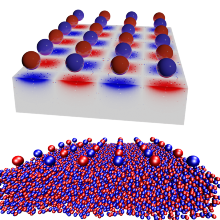New publication (University of Stuttgart/Université Grenoble Alpes/Sorbonne Université Paris), published in Nature Materials. The paper has been prepared within SFB 1313's research project C01 and SimTech project PN1-8.
Authors
- Alexander Schlaich (University of Stuttgart, SFB 1313 project C01)
- Dongliang Jin (TU Wien)
- Lydéric Bocquet (Université Grenoble Alpes)
- Benoit Coasne (Université Grenoble Alpes)
Abstract
Of particular relevance to energy storage, electrochemistry and catalysis, ionic and dipolar liquids display a wealth of unexpected fundamental behaviors - in particular in confinement. Beyond now well-documented adsorption, overscreening and crowding effects, recent experiments have highlighted novel phenomena such as unconventional screening and the impact of the electronic nature - metallic versus insulating - of the confining surface on wetting/phase transitions. Such behaviors, which challenge existing theoretical and numerical modeling frameworks, point to the need for new powerful tools to embrace the properties of confined ionic/dipolar liquids. Here, we introduce a novel atom-scale approach which allows for a versatile description of electronic screening while capturing all molecular aspects inherent to molecular fluids in nanoconfined/interfacial environments. While state of the art molecular simulation strategies only consider perfect metal or insulator surfaces, we build on the Thomas-Fermi formalism for electronic screening to develop an effective approach that allows dealing with any imperfect metal between these asymptotes. The core of our approach is to describe electrostatic interactions within the metal through the behavior of a `virtual' Thomas-Fermi fluid of charged particles, whose Debye length sets the Thomas-Fermi screening length λ in the metal. This easy-to-implement molecular method captures the electrostatic interaction decay upon varying λ from insulator to perfect metal conditions, while describing very accurately the capacitance behavior - and hence the electrochemical properties - of the metallic confining medium. By applying this strategy to a nanoconfined ionic liquid, we demonstrate an unprecedented wetting transition upon switching the confining medium from insulating to metallic.

Alexander Schlaich
Prof. Dr.Project Leader, Research Project C01


